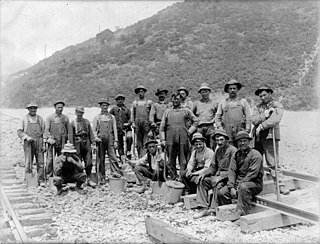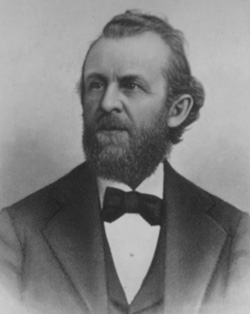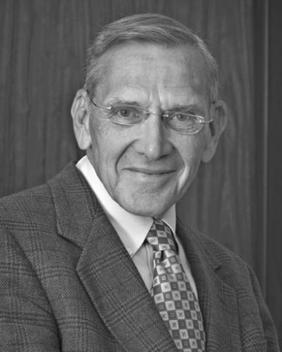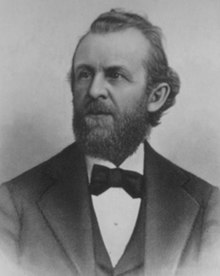
Brigham Young was an American religious leader and politician. He was the second president of the Church of Jesus Christ of Latter-day Saints from 1847 until his death in 1877. During his time as church president, Young led his followers, the Mormon pioneers, west from Nauvoo, Illinois, to the Salt Lake Valley. He founded Salt Lake City and served as the first governor of the Utah Territory. Young also worked to establish the learning institutions that would later become the University of Utah and Brigham Young University. A polygamist, Young had at least 56 wives and 57 children. He formalized the prohibition of black men attaining priesthood, and led the church in the Utah War against the United States.

The Mountain Meadows Massacre was a series of attacks during the Utah War that resulted in the mass murder of at least 120 members of the Baker–Fancher emigrant wagon train. The massacre occurred in the southern Utah Territory at Mountain Meadows, and was perpetrated by settlers from the Church of Jesus Christ of Latter-day Saints involved with the Utah Territorial Militia who recruited and were aided by some Southern Paiute Native Americans. The wagon train, made up mostly of families from Arkansas, was bound for California, traveling on the Old Spanish Trail that passed through the Territory.

The Utah War (1857–1858), also known as the Utah Expedition, the Utah Campaign, Buchanan's Blunder, the Mormon War, or the Mormon Rebellion, was an armed confrontation between Mormon settlers in the Utah Territory and the armed forces of the US government. The confrontation lasted from May 1857 to July 1858. There were some casualties, most of which were non-Mormon civilians. While the war had no notable military battles, Mormons did perpetrate the Mountain Meadows Massacre of 120 unarmed settlers who were passing through towards California.

The Mormon pioneers were members of the Church of Jesus Christ of Latter-day Saints, also known as Latter-day Saints, who migrated beginning in the mid-1840s until the late-1860s across the United States from the Midwest to the Salt Lake Valley in what is today the U.S. state of Utah. At the time of the planning of the exodus in 1846, the territory comprising present-day Utah was part of the Republic of Mexico, with which the U.S. soon went to war over a border dispute left unresolved after the annexation of Texas. The Salt Lake Valley became American territory as a result of the Treaty of Guadalupe Hidalgo, which ended the war.

The Liberal Party was a political party established in the latter half of the 1800s in Utah Territory before the national Democrats and Republicans established themselves in Utah in the early 1890s.

The People's Party was a political party in Utah Territory during the late 19th century. It was backed by the Church of Jesus Christ of Latter-day Saints and its newspaper, the Deseret News. It opposed Utah's Liberal Party.

William Samuel Godbe was a British convert to the Church of Jesus Christ of Latter-day Saints. He is remembered for leading a Mormon faction called the Church of Zion, better known as the "Godbeites".
The Mormon Reformation was a period of renewed emphasis on spirituality within the Church of Jesus Christ of Latter-day Saints, and a centrally-directed movement, which called for a spiritual reawakening among church members. It took place during 1856 and 1857 and was under the direction of church president Brigham Young. During the Reformation, Young sent his counselor, Jedediah M. Grant, and other church leaders to preach to the people throughout Utah Territory and surrounding Latter-day Saint communities with the goal of inspiring them to reject sin and turn towards spiritual things. During this time, some of the most conservative or reactionary elements of LDS Church doctrine came to dominate public discussion. As part of the Reformation, almost all "active" or involved LDS Church members were rebaptized as a symbol of their commitment. The Reformation is considered in three phases: a structural reform phase, a phase of intense demand for a demonstration of spiritual reform, and a final phase during which an emphasis was placed on love and reconstruction.

George Darling Watt was the first convert to Mormonism baptized in the British Isles. As a member of the Church of Jesus Christ of Latter-day Saints, Watt was a secretary to Brigham Young, the primary editor of the Journal of Discourses, and the primary inventor of the Deseret Alphabet.
Mormons have numerous significant instances of violence throughout their history as a religious group. In the early history of the United States, violence was used as a form of control. According to Mormon history, their members have faced persecution and forceful expulsion from where they have settled, such as being driven from Ohio to Missouri and from Missouri to Illinois during the lifetime of church founder Joseph Smith. Soon, those that followed one of Smith's successors Brigham Young settled in the Utah Territory and became the largest denomination of the Latter Day Saint movement, the LDS Church. Church history records that their migrations were accompanied by acts of violence that included massacres, home burnings, and pillaging.

Andrew Jenson, born Anders Jensen, was a Danish immigrant to the United States who acted as an Assistant Church Historian of the Church of Jesus Christ of Latter-day Saints for much of the early-20th century. Jenson also served the church as president of the Scandinavian Mission.
Although the Mountain Meadows massacre was covered to some extent in the media during the 1850s, its first period of intense nationwide publicity began around 1872. This was after investigators obtained the confession of Philip Klingensmith, a Mormon bishop at the time of the massacre and a private in the Utah militia. National newspapers also covered the John D. Lee trials closely from 1874 to 1876, and his execution in 1877 was widely publicized. The first detailed work using modern historical methods was published in 1950, and the massacre has been the subject of several historical works since that time.

Edward Wheelock Tullidge was a literary critic, newspaper editor, playwright, and historian of the Utah Territory, US. He was a member and leader in several different denominations of the Latter Day Saint Movement, including the Church of Jesus Christ of Latter-day Saints, the New (Godbeite) Movement movement, and the Reorganized Church of Jesus Christ of Latter Day Saints. He played a significant role in the creation of the Salt Lake Tribune newspaper.
The conspiracy and siege of the Mountain Meadows Massacre was initially planned by its Mormon perpetrators to be a short "Indian" attack, against the Baker–Fancher party. But the planned attack was repulsed and soon turned into a siege, which later culminated in the massacre of the remaining emigrants, on September 11, 1857.

Women's suffrage was first granted in Utah in 1870, in the pre-federal period, decades before statehood. Among all U.S. states, only Wyoming granted suffrage to women earlier than Utah. Because Utah held two elections before Wyoming, Utah women were the first women to cast ballots in the United States after the start of the suffrage movement. However, in 1887 the Edmunds–Tucker Act was passed by Congress in an effort to curtail Mormon influence in the territorial government, disallowing the enfranchisement of the women residents within Utah Territory. Women regained the vote upon Utah statehood in 1896, when lawmakers included the right in the state constitution.

Ronald Warren Walker was an American historian of the Latter Day Saint movement and a professor at Brigham Young University (BYU) and president of the Mormon History Association. His work, acclaimed by the Mormon History Association, dealt with the Godbeites, the Utah War, and the Mountain Meadows Massacre, among other topics.
Thomas Brown Holmes Stenhouse was an early Mormon pioneer and missionary who later became a Godbeite and with his wife, Fanny Stenhouse, became a vocal opponent of the Church of Jesus Christ of Latter-day Saints.
This is a bibliography of works on the Latter Day Saint movement.

Charlotte Ives Cobb Kirby was an influential and radical women's rights activist and temperance advocate in the state of Utah as well as a well-known national figure. Charlotte was born in Massachusetts and at seven years of age moved to Nauvoo, Illinois with her mother, an early member of the Church of Jesus Christ of Latter-day Saints. There, without divorcing father Henry Cobb, her mother became Brigham Young's second plural wife. They then moved to Utah in 1848. Charlotte, previously a plural wife herself, spoke out against polygamy and gained much opposition from polygamous women suffragists because of it. Her first marriage was to William S. Godbe, the leader of the Godbeite offshoot from the LDS Church. After divorcing Godbe, Kirby married John Kirby, a non-LDS man, and they were together until Charlotte's death in 1908. Charlotte was a leading figure of the Utah Territory Woman Suffrage Association, and served as a correspondent to the government and other suffragist organizations, including the National Women's Suffrage Association. Charlotte often traveled to the East Coast to deliver lectures regarding women's rights and temperance, the first Utah woman and the first woman with voting rights to speak to national suffragist audiences. Charlotte Ives Cobb Kirby died on January 24, 1908, at age 71 in Salt Lake City, Utah.












